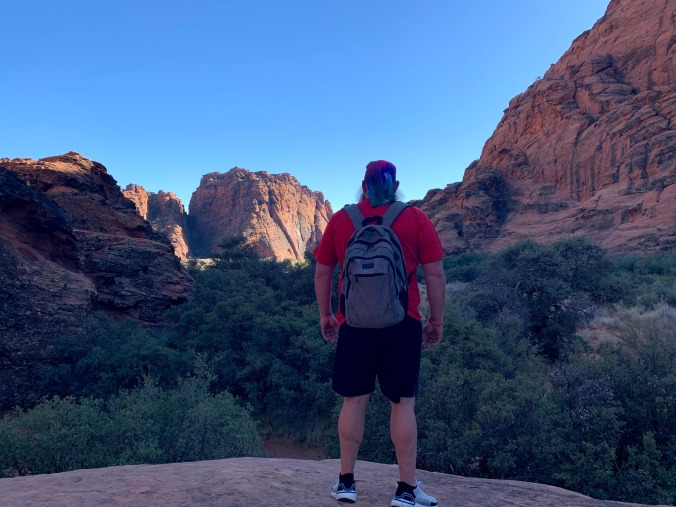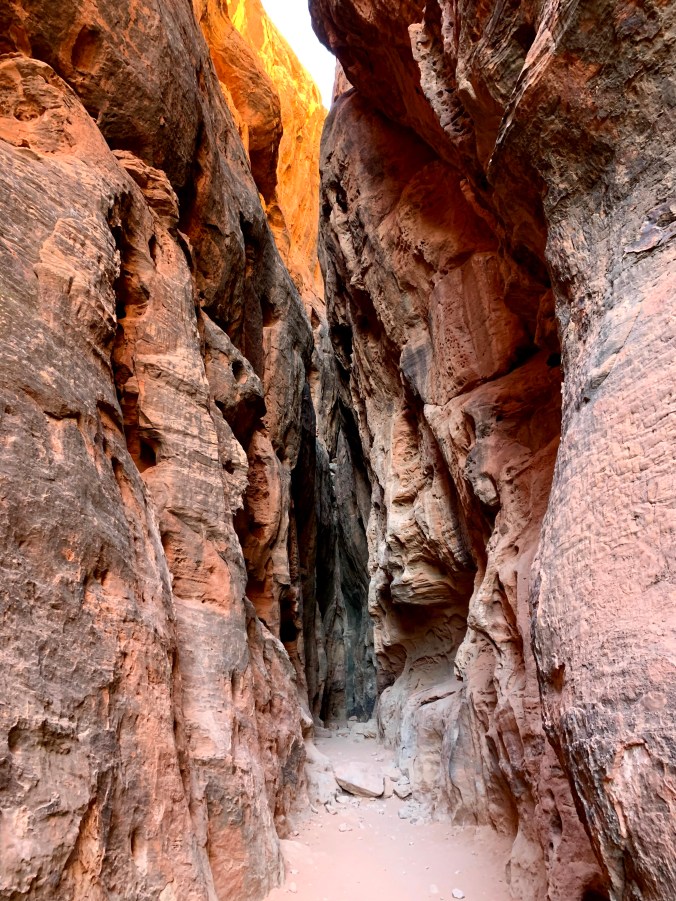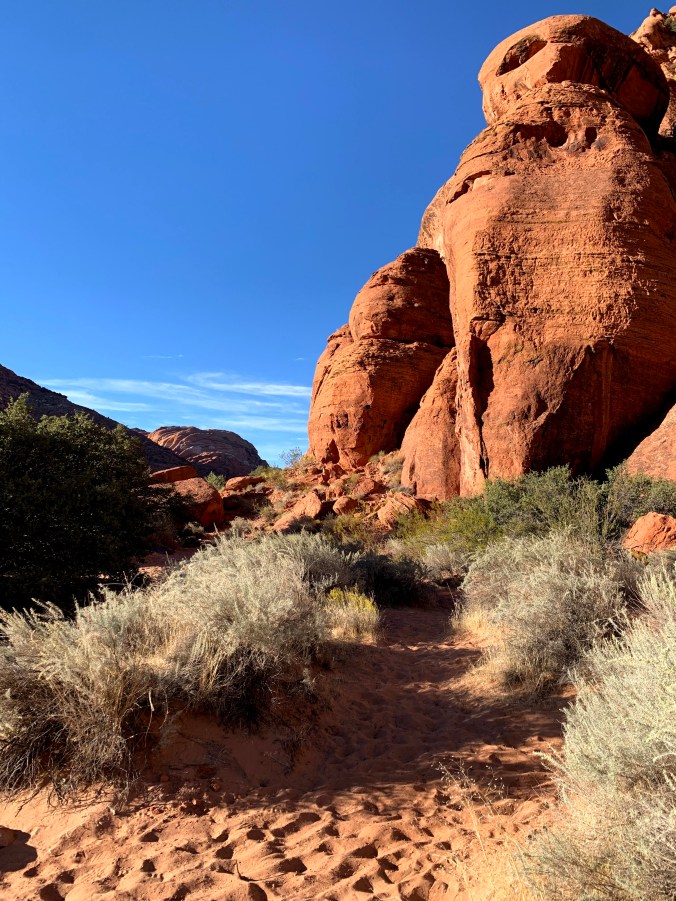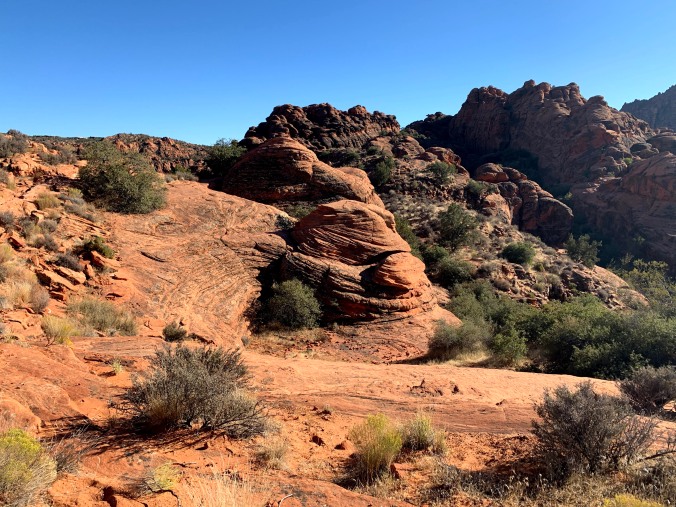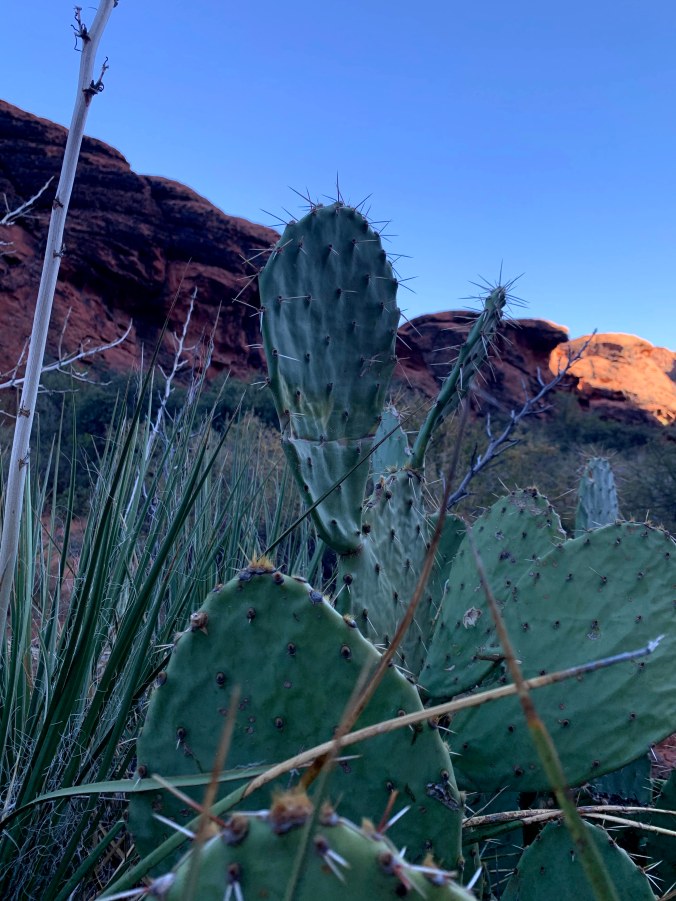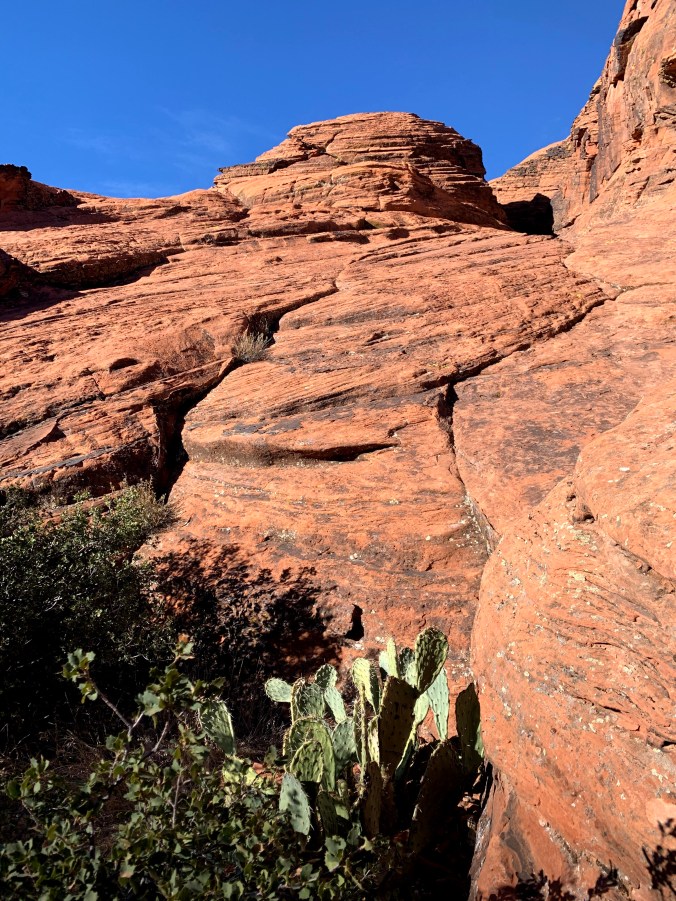Snow Canyon State Park won over our hearts three years ago on our first road trip to Utah. It wasn’t on our radars at all, but a coworker highly recommended stopping on our drive through Utah. We needed to find camping outside of Zion National Park anyway—Snow Canyon is an hour away—so after learning the park had a campground we booked a site for the night and didn’t think much more of it, just happy to have a place to sleep for the night. What we thought was just a random lodging stop on our road trip wound up being one of our favorite campsites ever! I remember pulling into the park and being wowed by the red, orange and creamy colored striped cliffs and canyons surrounding us. It was the tail end of our trip, I believe we had two days left to explore both Zion and Bryce Canyon National Parks, so we just didn’t have the time explore Snow Canyon the way it deserved! I vowed that on our next trip to Utah we would make time for that gorgeous place.
Getting to Snow Canyon
Fast forward three years with a Utah road trip is in the works, you best believe Snow Canyon was one of the first destinations on our list. The state park is located eight miles north of St. George, Utah on Route 18. Due to its proximity to Zion and because we loved the campsite so much, we had hoped once again to make it our basecamp for a few days. Unfortunately lots of people love Snow Canyon, it’s a very popular state park and all the sites were reserved during our trip. With a little more advance planning we likely could have snagged a site, but we’re very spontaneous travelers—we tried making reservations about a week prior to arriving! We were lucky to score a couple nights at nearby Quail Creek State Park, a short 30 minute drive from Snow Canyon, and only 40 minutes from Zion.
On the second day of our Utah road trip, we left the Bonneville Salt Flats in Wendover early that morning and drove five hours on desolate backroads through Nevada to Snow Canyon, planning to arrive by early afternoon so we had plenty of time to explore the park. You’d expect to drive through Utah, but our directions had us on the Great Basin Highway for the majority of the way; a drive through the beautiful desert and mountains of Northern Nevada. There really isn’t much going on out there besides stunning scenery; at one point there was a sign that read “no services for 130 miles!” Be sure to pack water and snacks, and gas up before heading out on these backroads. Upon reaching Panaca, Utah, we left the Great Basin Highway for the last leg of our drive into Snow Canyon.
Activities at Snow Canyon State Park
There is a $15 day use fee to visit Snow Canyon State Park. Unlike some park passes that are valid for several days, these passes are only good for one day. Recreational activities are plenty at Snow Canyon, including biking, technical climbing, canyoneering (though special permits are required), horseback riding, scrambling, i.e. non-technical climbing, and 38 miles of hiking trails to enjoy. You’ll receive a great detailed map upon checking into the park that lists all the hiking trails, distances and what can be found along each trail. Some trail highlights include lava tubes and fields, an extinct volcano, slot canyons, sand dunes, and unique plants and wildlife. The park campground has 33 sites available with electric and water hookups for both tent and RV campers, as well as access to restrooms and showers. The campground is located right in the middle of the park and is surrounded with stunning views of the cliffs. We also loved that the tent sites were filled with sand, making for a nice soft pad for the tent; we even considered ditching the air mattress! After nearly a week of camping out of a car it was super convenient to have access to the electricity for charging our electronics and the potable water. To see a photo of our campsite, check out the featured picture in our post How to Start Packing for a Road Trip.
Geology, Plants & Animals of Snow Canyon
Snow Canyon State Park features lava flows and sandstone cliffs, spanning 7,400 acres within the Red Cliffs Desert Reserve. Give or take 183 million years ago, natural processes caused huge sand dunes to eventually cement into stone, primarily Navajo sandstone, which was then cut by water to form canyons throughout the landscape. Millions of years later, but as soon as 27,000 years ago, nearby cinder cones erupted and lava flowed into the canyons, filling them with basalt. This redirected the water yet again, creating more new canyons. Wild right?! Snow Canyon is also home to diverse plants and wildlife not found anywhere else in Utah. With very little rainfall per year, most of the plants are desert adapted. During the right conditions in the spring and fall, wildflower blooms are not uncommon. There are fourteen protected and sensitive species living within the park, including peregrine falcons and Mojave desert tortoises. We hoped to see a tortoise, as there were signs all over the park warning people to slow down and look out for them, but unfortunately the little guys didn’t come out for us. If you’re interested to learn more about the biodiversity at Snow Canyon, make sure to stop by the park headquarters to grab plant and wildlife checklists.
Our Adventures at Snow Canyon State Park
Honestly, I still don’t feel like we had enough time to truly explore Snow Canyon in half a day! But we were still able to complete three short hikes and drive the scenic road a few times. The park brochure describes 13 different hikes from a half mile to eight miles in length. We chose two easy and short hikes, the Pioneer Names and Jenny’s Canyon, along with the slightly longer and moderately rated Hidden Pinyon trail.
We started with the Pioneer Names trail, a short half-mile, easy, and mostly flat walk that passes by pioneer names that were written on the sandstone in axle grease, dating back to 1881. It’s pretty amazing how visible the names are after so many years!
The Hidden Pinyon was appealing because there were only a couple cars parked at the trailhead and it was rated as a moderate 1.5 mile hike. The Hidden Pinyon trail intersects with multiple trails a few times, but if you pay attention to the markers and bring your park brochure map, you shouldn’t have any trouble staying on course. This is a self guided nature trail highlighting geologic features and native plants along the way. A good portion of the hike is in sand, along with a few rocky slopes and drop-offs mixed in. We had lots of fun climbing over and around some of the rocks, and even discovered a little rock slide! Pro-tip: sandstone doesn’t make for a great slide, very grippy! I figured I probably wouldn’t slide well but also couldn’t help myself from trying!
Jenny’s Canyon is a very popular half-mile easy and mostly flat hike that leads to a short but impressive slot canyon. This is a great trail for kids, and as such, we did see many kids on it—they loved playing around in the slot canyon and climbing the walls. Jenny’s Canyon was probably the busiest trailhead; we kept driving by waiting to snag a parking spot. However, we found that it started to die down later in the afternoon. We were fortunate to get at least five uninterrupted minutes in the slot canyon by ourselves, and after returning to the parking lot found plenty of open spots, which had not been our experience earlier that afternoon.
Overall we love Snow Canyon State Park even more now that we’ve been back to explore more than the campground! We’ll definitely visit Snow Canyon again in the future, but we’ll also plan smarter and book our campsite in advance. Feel free to reach out if you have any questions about visiting this awesome state park in Utah, and if you’ve been there before please tell us in the comments about your favorite hikes and activities at Snow Canyon. Stay tuned for our next couple blog posts about our two adventurous days at Zion National Park!


